verticality
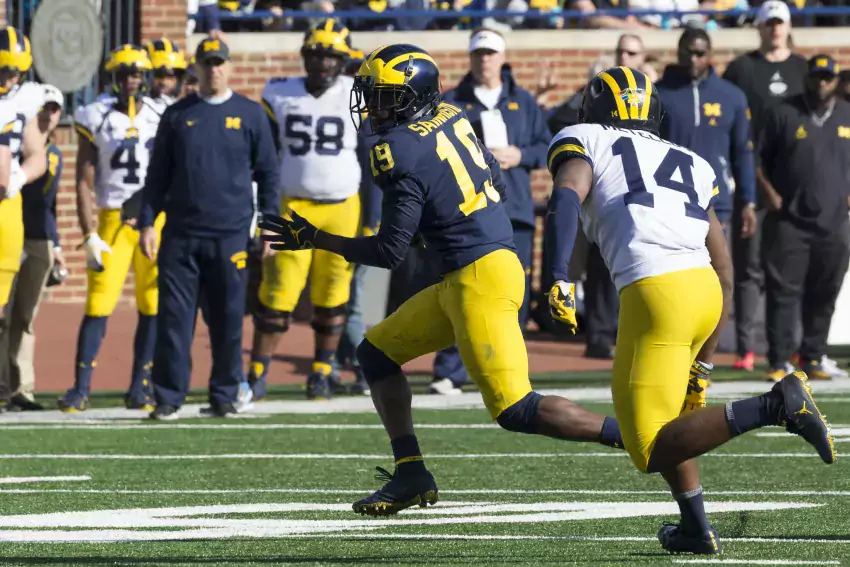
So you know Josh Gattis has a philosophy. Michigan's new offensive coordinator, a former safety with a short trip in the NFL, spent the bulk of his coaching career as part of the brain trust propping up James Franklin. Two of those seasons came under Joe Moorhead, now head coach of Mississippi State, and one of the premier offensive minds in the game.
Now, the concept of speed in space is just barely more modern than toughness. What we're really talking about when we say "philosophy" is a slider: how much do your play designs emphasize that one aspect, and how. In historical Franklin spreads—and Rich Rodriguez offenses I should add—the stress put on the defense is extremely horizontal.
Verticality was an important changeup of course but note that resources in his base play are all about generating horizontal spacing: the defensive front has to control outside gaps that are widening every second, with the QB run and a pre-snap bubble read to force defenses to keep their material to the backside.
Moorhead's philosophy, however, is extremely vertical. Take the first two plays he ran against us in 2017:
These plays also threaten horizontally—that second play is an Inverted Veer, the modern cousin of the standard "get to the edge or cut behind overpursuit" play of the 20th century. He's flipped the QB and RB for some extra flavor but the base concept is to drag three defenders far away from the play on the wide side and threaten to run outside the other way, pulling a backside guard and optioning the last guy on the line of scrimmage to get numbers over there.
But note how he uses the receivers here. In both instances Moorhead is using three of his eligible receivers to go long, and running a fourth underneath. It's a big material commitment, but a hallmark of his offenses. And they're not just for show; Moorhead's offenses almost always feature one or two receivers with double-digit TDs and 17 yards per catch on 55% catch rates to back up his Dr. Strangelove reputation.
Other hallmarks of Moorhead designs are he likes to get underneath defensive players moving laterally before and after the snap, and he likes to use creative options and things that look like options to freeze edge defenders. Coach Matt Wyatt of RenasantNation.com had a great video last year on Moorhead's offense and the creative ways they got the ball to Saquon Barkley, but see if you can see these concepts at play:
Warning: Our 2017 Penn State game features after some OSU & MSU
Given Josh Gattis really comes from the Franklin tree, I was very interested in the Spring Game to see how much of Moorhead he'd adopted. The answer: I think most of it.
[After THE JUMP: Al Borges?!?]

2/21/2019 – Michigan 69, Minnesota 60 – 24-3, 13-3 Big Ten
If you could go back in time six months and give your past self a stupefying Michigan sports update, your #2 option would be "Michigan basketball is 24-3 and it's tough to decide whether Zavier Simpson or Jon Teske is our best player." We will not discuss #1.
The needle swung to Simpson after the Maryland game, when he had 12 points on seven shot equivalents, 8 assists, one turnover, and more or less shut off Anthony Cowan for a half. The pendulum swung back to Teske in this one: 17 points on 11 shot equivalents, two assists, five blocks. Even more stunning: 36 minutes.
Teske sometimes seems to take his foot off the gas a little bit in the post, whether that's marshalling his strength or trying to avoid foul trouble. But every game he does enough to hold whoever he's directly checking to meh numbers (Oturu had 18 points on 18 shot equivalents and a TO) while hedging everyone's ball-screen game into oblivion and coming in for help defense on the regular. There's a point in every game where Teske gets a closeup and my reaction is "my goodness that person is red," but dude just keeps going. Michigan would be dead in the water if he could only play 20 MPG like a lot of guys his size. He is Camp Sanderson's magnum opus.
Anyway:
That's Minnesota for you. It took Minnesota 28 minutes to make a basket outside of the paint. The Gophers had 18 points at halftime. Eight of these were on initial attempts. They were able to claw ten more out off of putbacks, which is a little frustrating since the Gophers haven't been that good at OREBs in league play and Michigan has maintained their DREBs much better than they usually do.
The margins are are pretty thin. Given the number of rebounding opportunities Minnesota had (47!) Michigan would expect to give up 12.5 OREBs; instead they gave up 15. This places it into a category where we're mildly frustrated about bounces.
In part because of the above this was a game in which the Gopher had a huge shot volume edge. They had 7 more OREBs than TOs. Michigan was –4. To hold a team with a shot volume index over one to 0.9 PPP means you are crushing them everywhere except the offensive boards.
wall up! [Ludeman]
Verticality. Part of the trouble the Gophers had was their tendency to run pell-mell at the rim and try to chunk something up. That style is why they lead the league in free throw rate. In this one it mostly led to very tough attempts after taking contact. This was most notable on two missed dunks where Teske walled up vertically and contested.
Doink pic.twitter.com/Y7uILIYeWu
— Noah Neidlinger (@candor_for_sale) February 22, 2019
Amir Coffey's bounced spectacularly outside the three point line; Teske was called for a foul on a near-identical Jordan Murphy play. (Murphy missed both FTs, ball don't lie.)
With the exception of that foul, though, the officials allowed Michigan to contest.
When verticality is called correctly it's such an excellent rule change, rewarding defenses for being in good position without flopping and placing a priority on open shots for the offense all the way to the rim. The best example in this game was not either Teske contest but Amir Coffey getting downhill only for Simpson to show. Simpson was outside the restricted arc (I think) but instead of trying to flop he went up to contest; Coffey bumped him, missed the ensuing tough shot, and Michigan rebounded. That is infinitely superior to a guy standing on the ground and falling over in the hopes of stopping the game with a foul call.
[After THE JUMP: attacking switches, finally]

2/18/19 – Michigan 65, Maryland 52 – 23-3, 12-3 Big Ten
A year ago Ace and I had a disagreement about Zavier Simpson in which I asserted he'd probably never be a 20% usage guy. A year later I'm technically, barely correct because of rounding; Ace is spiritually and functionally correct. Simpson is simultaneously a 19.4 usage guy with a meh 106 ORTG and the source of panicked consternation whenever he's not on the court.
In my defense I did not foresee Simpson bringing the skyhook back, because I am not insane.
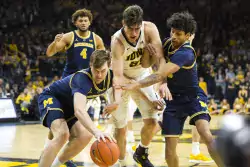
Michigan doesn't have a backup 5, and that's bad
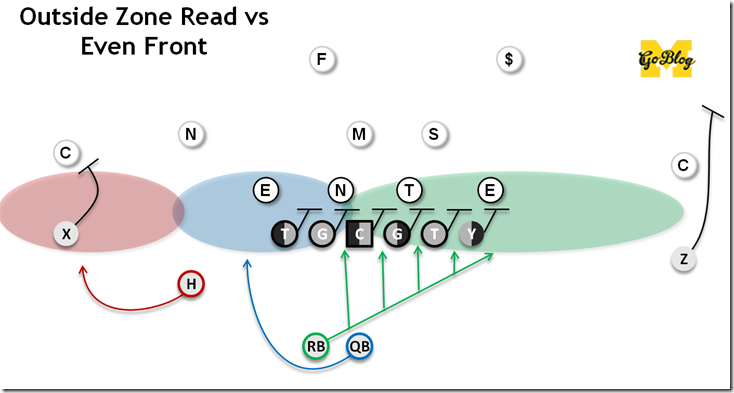
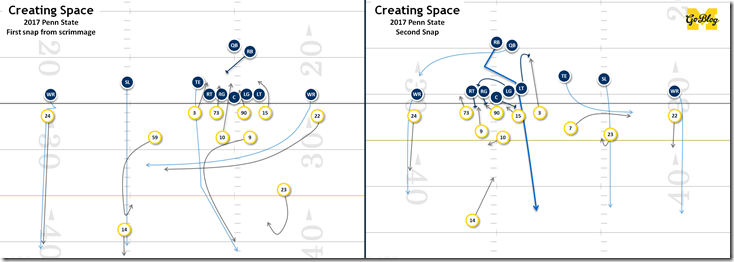
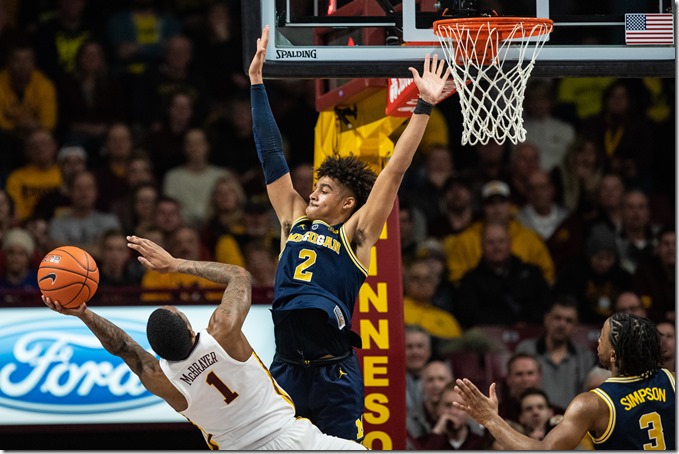
51